
It’s impossible to understate how important water is in our everyday lives. Just think about how many things you need running water for — drinking, cooking, washing your hands, taking a shower and even more.
But how did people live before modern plumbing systems? They built aqueducts. From Ancient Rome to the Mayan Empire, here’s a deep dive into the fascinating history and facts about aqueducts.
In This Article
- What Are Aqueducts?
- How Do Aqueducts Work?
- Aqueducts in the Ancient World
- Aqueducts in the Middle Ages and Renaissance
- Aqueducts in Modern Times
- Visit Historical Aqueducts With Windstar Cruises
What Are Aqueducts?
An aqueduct is a water distribution system that redirects water from sources across the land to crops or urban centers. These systems would provide a consistent supply of fresh water to dry areas, allowing populations to thrive and grow.
In cities, aqueducts significantly improved public health by eliminating the need to store stagnant water, which could lead to water-borne diseases like cholera or typhoid fever. Aqueducts also helped separate wastewater from clean water, further reducing the risk of infection.
Today’s aqueducts still serve the same purpose, though they are more technologically advanced. Aqueducts now supply water to major cities, like New York City and Los Angeles, sustaining the people there and enabling a high standard of living.
How Do Aqueducts Work?
Aqueducts rely on water pressure and the force of gravity to draw water away from natural sources, such as creeks and rivers, into a town or city. They connect to the water source and redirect it through the system to a distribution channel, which can be anything from a well to a fountain or a storage tank.
Most aqueducts combined long underground systems of pipes and aboveground channels to create a continuous flow of water from the source to the destination. These piping systems were made from many different materials over the years, including:
- Lead
- Terra cotta
- Clay
- Wood
- Cast iron
- Bronze
Nowadays, engineers usually build aqueduct pipes using cast iron or steel. These materials work well with modern aqueduct systems, which also use techniques like pressurization and pumps to push water along.
Aqueducts in the Ancient World
So, who invented aqueducts? Because these structures appeared in multiple early civilizations, there isn’t a definite answer as to where the first aqueduct originated.
The Earliest Aqueducts
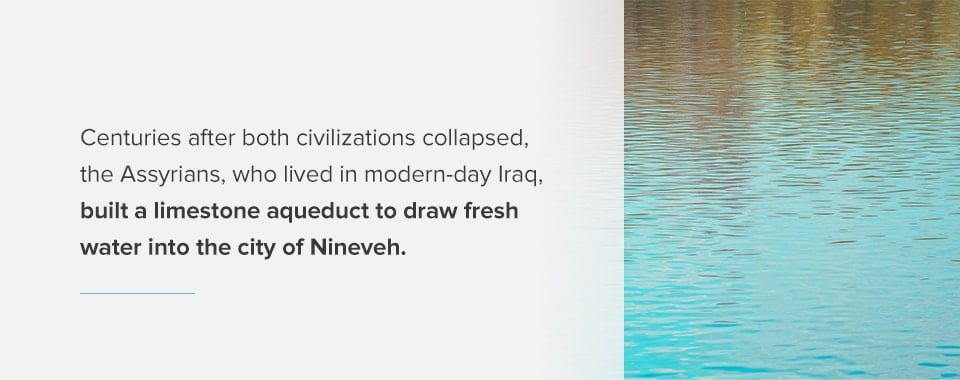
The first records of aqueducts are from two Bronze Age civilizations:
- Minoan: Active on the Greek island of Crete from around 3000 to 1100 B.C., this civilization constructed early aqueducts using inverted clay tiles and pipes. Although these early systems could only transport water over short distances, they enabled the Minoans to build impressive water management systems.
- Indus: The Indus Civilization was active along the Indus River from 2500 to 1700 B.C. Their aqueduct system allowed them to supply water to more than 700 wells in the city of Mohenjo-Daro as well as build a sophisticated plumbing system. Believe it or not, each house in the city had its own plumbing!
Centuries after both civilizations collapsed, the Assyrians, who lived in modern-day Iraq, built a limestone aqueduct to draw fresh water into the city of Nineveh. This system used longer tunnels than the earlier aqueducts, which enabled them to bring water directly into the city.
Greek Aqueducts
The Romans took control of Greece in 146 B.C., so most of the later Greek aqueducts were actually Roman-made. However, there are some early Greek structures that were built before the Roman occupation.
Some of the most remarkable Greek aqueducts include:
- Eupalinos Tunnel: This 1,036-meter tunnel traces its history all the way back to the sixth century B.C. It supplied water to the city of Samos for more than a millennium before its abandonment in the Byzantine era. Now, it’s a popular tourist destination.
- Nikopolis Aqueduct: This 50-kilometer-long aqueduct supplied fresh water to the large city of Nikopolis. The Romans constructed this aqueduct to commemorate Emperor Octavian Augustus’s victory against Marc Antony in the War of Actium.
- Hadrian’s Reservoir: Due to a rising need for fresh water in second-century Athens, Roman Emperor Hadrian ordered the construction of a new water management project. The aqueduct, which transported water 12 miles from Mount Parnitha to Mount Lycabettus, emptied into a reservoir under the city.
Many of these ancient aqueducts have been repurposed to fit the needs of today’s people. For example, Hadrian’s Reservoir no longer provides drinking water to the city — instead, it’s now home to an outdoor movie theater.
Roman Aqueducts
The Romans are the shining stars of aqueduct engineering, improving the earlier designs to serve cities throughout the Empire. With their high stone arches, you’ll know their aqueducts when you see them.
Most of the aqueduct system consisted of stone or terra cotta pipes running through underground tunnels. Occasionally, the systems also included small waterfalls that aerated the water.
The iconic stone arches made up only a small portion of the Roman aqueduct system. However, it was these arches that made large-scale water distribution systems possible.
Aqueducts supplied water to Roman cities throughout Europe and the Middle East, and many ruins are still around today. Some examples include:
- Aqua Alexandrina: One of the last Roman aqueducts, construction for Aqua Alexandrina concluded in A.D. 235. What makes it unique is that, unlike other aqueducts, almost all of the structure consists of aboveground arches. Visit Via dei Pioppi and Via degli Olmi to see the remains in Rome.
- Aqua Claudia: Construction for this aqueduct began under the infamous Emperor Caligula in A.D. 38 and concluded under Emperor Claudius in A.D. 54. Most of Aqua Claudia runs underground, but you can see some of the ruins at Parco Degli Acquedotti and the Via Lemonia in Rome.
- Valens Aqueduct: This two-tiered aqueduct in modern-day Istanbul was built during the rule of Emperor Valens in the fourth century. As the longest ancient aqueduct, it’s well worth a visit.
- Segovia Aqueduct: Located in Segovia, Spain, this double-decker aqueduct is one of the city’s most iconic symbols.
- Pont du Gard Aqueduct: Located in modern-day Nimes, France, this aqueduct once provided water to the Roman colony of Nemausus.
Perhaps the most well-known Roman aqueduct is the Aqua Virgo, or the Aqueduct of the Virgin. The aqueduct has legendary roots — it was built around 19 B.C. to commemorate the spot where a young maiden miraculously created a spring of fresh water for Roman general Marcus Agrippa and his men.
During the time of the Empire, the Aqua Virgo remained a simple aqueduct. But now, centuries later, it ends in a national landmark.
Persian Aqueducts
Many other ancient civilizations devised ways to supply their cities with fresh water. Although these systems were similar to aqueducts in theory, they were different in execution.
For example, engineers of the Persian Empire created qanats from around 550-331 B.C. Qanats were large underground channels that sloped downward to allow gravity to pull water from its source to its destination. Throughout the trail, the qanat has vertical aeration channels that expose the water to fresh air.
Many of these original qanats are still in use for farmland irrigation today. Aerial photographs of them show long lines of holes in the desert sands, which are the shafts that expose the water to air.
Aqueducts in the New World
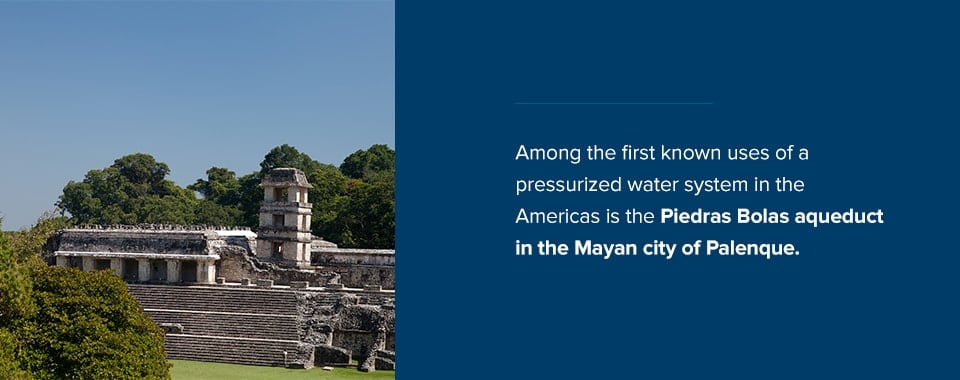
On the other side of the world, civilizations in South and Central America created their own aqueduct systems.
The Incan Empire, which was active from the early 15th century to the late 16th century, built sophisticated aqueducts on the sides of mountains. These systems collected mountain water, which the Incas primarily used to irrigate their crops. Many of these original aqueducts are still in use today! Just look at Machu Picchu. The terraces on the mountain collect and channel water down the slope.
Moving further north, among the first known uses of a pressurized water system in the Americas is the Piedras Bolas aqueduct in the Mayan city of Palenque. Piedras Bolas redirects water from a nearby stream, which flows downhill. The tunnel narrows at the bottom, increasing water pressure and creating a fountain that could shoot water aboveground up to 20 feet high. Although it has long been abandoned, this aqueduct is still active to this day.
Aqueducts in the Middle Ages and Renaissance
The chaos and societal reorganizing of the early Middle Ages resulted in the loss of many of the original Roman aqueducts. In the Empire’s final years, invading Germanic tribes would often cut Rome’s water supply as part of their attacks.
As the age of the old empires came to a close, new feudal kingdoms rose from their remains. Many of these new civilizations were unable to restore the old aqueducts for generations.
Medieval Aqueducts
After the collapse of the Empire, most of the old Roman aqueducts fell into disrepair. Historical records suggest that warring estates may have used the underground structures as secret passages into their enemies’ land. Or, in the case of siege warfare, they would cut a city’s water supply to starve them out and force a victory, resulting in a broken aqueduct.
In Rome, several medieval Popes attempted to repair the old aqueducts:
- Pope Gregory II: Restored the water supply to baths in the San Lorenzo Fuori le Mura (Saint Lawrence Outside the Walls) Basilica in Rome in the early eighth century
- Pope Adrian I: Made significant repairs to multiple Roman aqueducts in the 770s
- Pope Nicholas V: Began restoration on the Aqua Virgo aqueduct in the early 15th century
Despite this progress, many of the restored aqueducts fell back into disuse by the ninth century — historical references to functioning aqueducts stopped in the 12th century. As a result, most medieval European civilizations returned to fetching water from wells and nearby rivers.
Interestingly, some regions built new aqueducts during this period. The Aqueduct of Biar in Spain was built for irrigation purposes in the late 15th century. Designed by architect Pere Comte, this aqueduct has three arches — notably, two are pointed in the Gothic style of the High Middle Ages.
Renaissance Aqueducts
The Renaissance saw a revival in Romanesque architecture and art, which sparked newfound interest in the old aqueducts. Restoration projects began throughout the period, but only one resulted in a functioning aqueduct.
In 1570, Pope Pius V completed the restoration of the Aqua Virgo, which is the only original Roman aqueduct still in use. Today, this aqueduct supplies fresh water to the Trevi Fountain in Rome.
Several new aqueducts also arose during this period as engineers rediscovered how to build them. In the late 16th century, for example, Pope Sixtus V ordered the construction of the Felice Aqueduct. This new structure, which ends in the Fontana dell’Acqua Felice or Fountain of Moses, greatly improved living conditions for Roman citizens.
Aqueducts in Modern Times
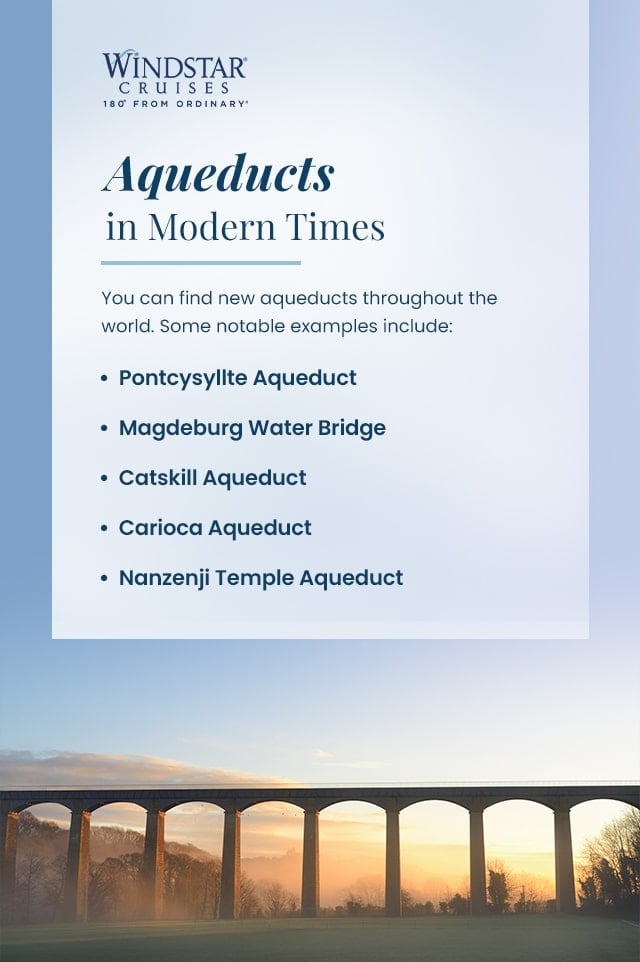
The Industrial Revolution of the 18th and 19th centuries revived interest in aqueducts for practical purposes. Scientific advancements such as steam pumps and improved pressurized systems enabled engineers to build aqueducts that followed the land’s natural contours. Rather than having to rely solely on gravity to move water, engineers could build structures that transported water against its natural flow.
Canal building also surged due to the Industrial Revolution. Architects began working on navigable aqueducts, which are essentially water bridges that transport small- to medium-sized cargo ships over a stretch of land. This innovation reduced travel distances and helped conserve canal water.
You can find new aqueducts throughout the world. Some notable examples include:
- Pontcysyllte Aqueduct: This beautiful UK aqueduct is part of a longer canal system that connects the Welsh highlands with the English lowlands. UNESCO named the Pontcysyllte Aqueduct a World Heritage Site in 2009.
- Magdeburg Water Bridge: The world’s longest navigable aqueduct connects two important German waterways — the Mittellandkanal to the Elbe-Haval Canal.
- Catskill Aqueduct: This simple New York aqueduct is completely underground. Like its Roman predecessors, it relies on the force of gravity to supply New York City with fresh water from the Ashokan Reservoir.
- Carioca Aqueduct: Located right in the center of Rio de Janeiro, Brazil, this former aqueduct once transported water to the city from the Carioca River. It’s since been adapted to serve as a tram bridge.
- Nanzenji Temple Aqueduct: This stunning red Roman-style aqueduct sits on the grounds of the Nanzenji Buddhist Temple in Kyoto, Japan. Built during the Meiji era at the end of the 19th century, the aqueduct still transports water to Kyoto from Lake Biwa.
Although most modern architects build aqueducts in a drastically different style from the grand Roman arches of the past, they’re still quite beautiful. So make sure to stop and snap a few photos if you happen to come across one on your travels.
Visit Historical Aqueducts With Windstar Cruises
If you’re as fascinated by ancient architecture as we are, you’ll love traveling with us. Our small, intimate ships let you explore the world beyond the usual tourist destinations.
You can customize your on-shore excursions to visit architectural wonders and immerse yourself in local culture. Whatever you want to learn, we’ll help you satisfy your curiosity.
Request a call today to learn more about our cruise offerings. We look forward to seeing you on board.
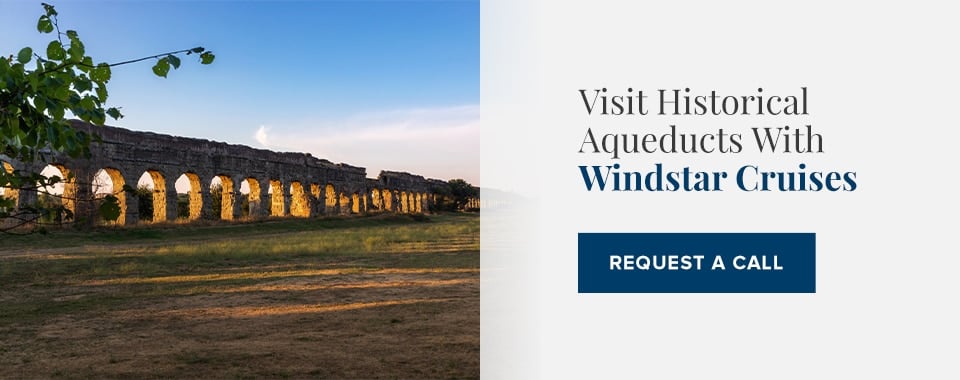















































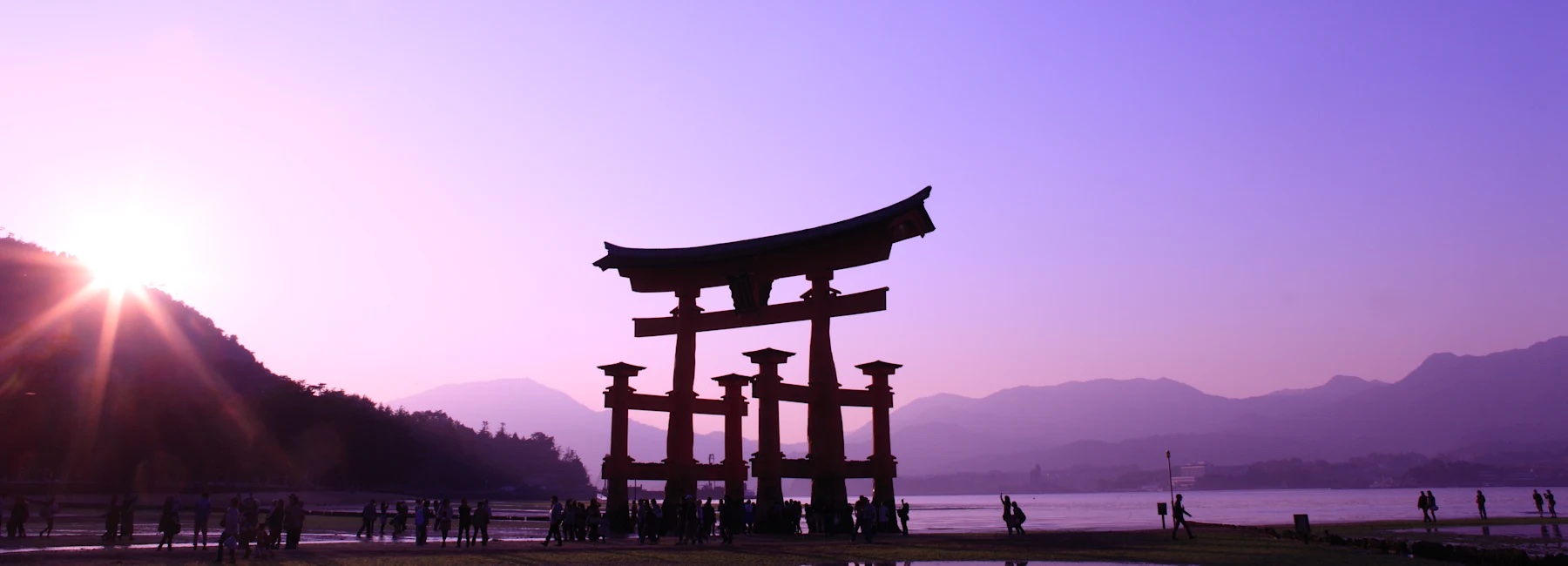




Hi I have been reading this blog and I think there are many misconceptions or false information in your work. Uhm… The greeks did not built the first aqueducts in the world, the earliest waterways systems dates back to ancient persian period where qanats are implemented that dated around 700 B.C. The greeks on the other hand built their first true aqueduct around 600-300 B.C., while the romans adapted them and made them more popular. The real discovery of waterways systems does not fall to any specific timeline but rather evolved overtime. Also, please try to add references on your… Read more »
Thanks, Aliyasa. We’ll take this story down until we can revise it. –Carolyn